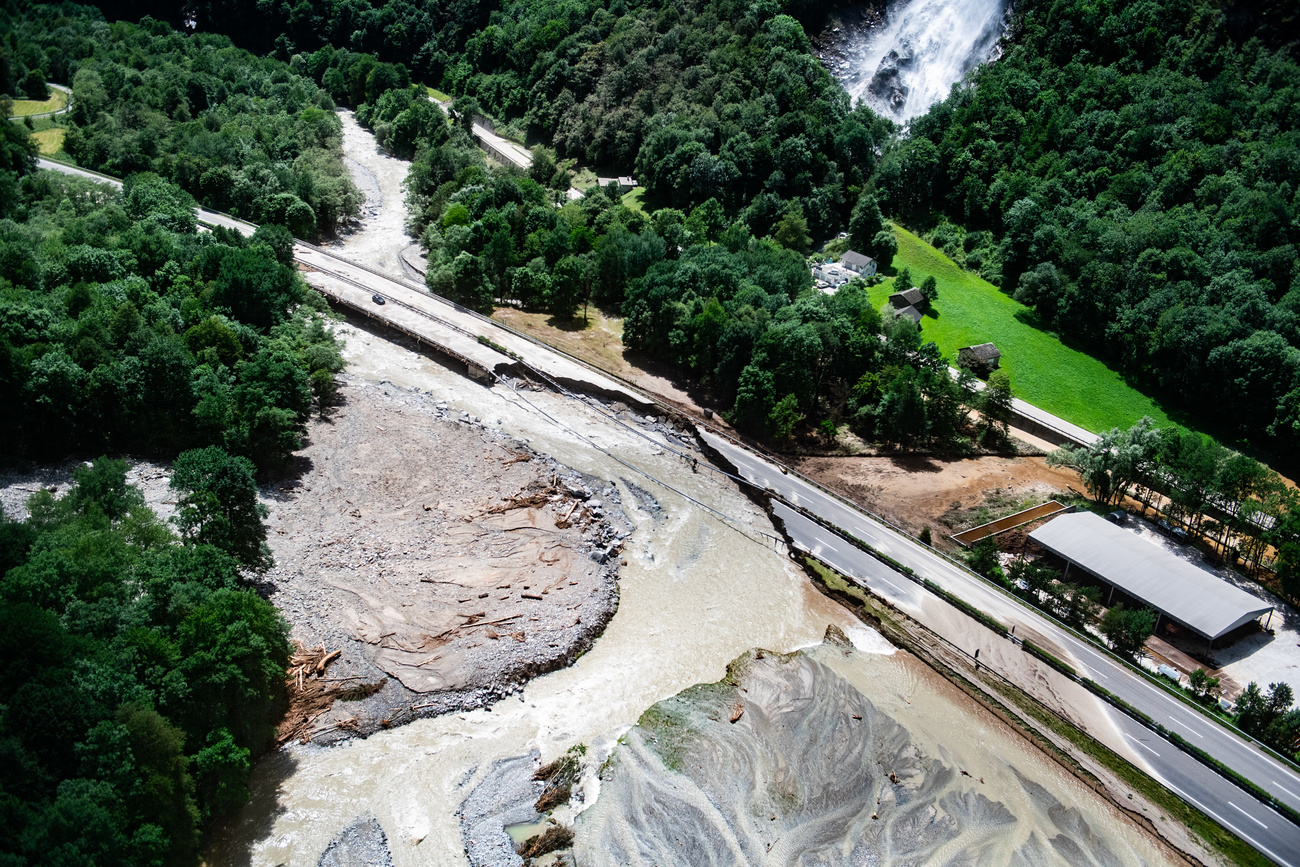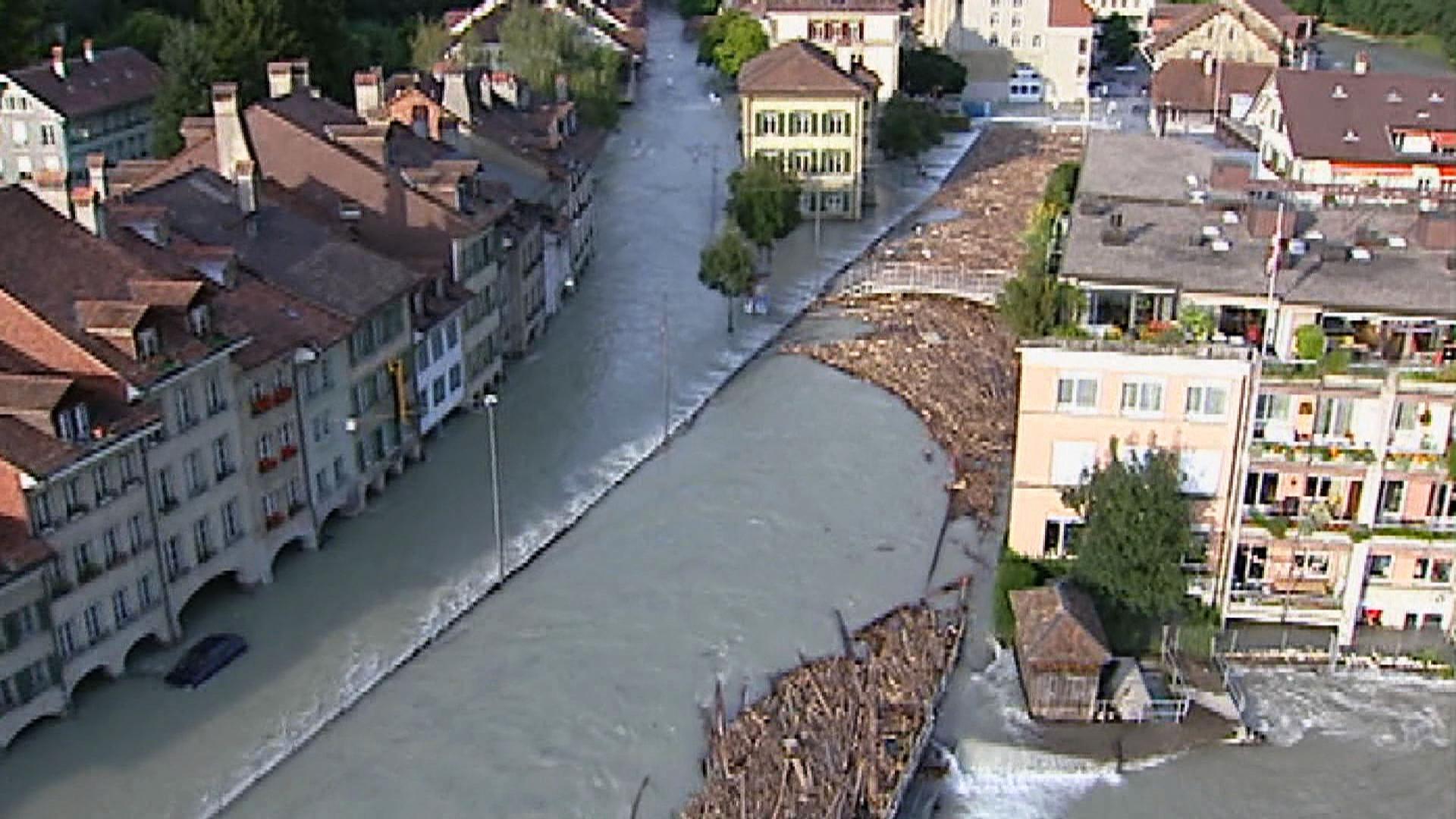How Switzerland is trying to defeat extreme weather events

Switzerland has been scrambling to build up its flood defences since the “flood of the century” in 2005 left parts of the country under water, causing CHF3 billion in damage and claiming seven lives.
Billions of francs have since been spent on beefing up flood defences. More money is being poured into solutions, including a CHF1 billion pledge to protect the Rhine Valley between Switzerland and Austria over the next three decades.
But such measures once again proven inadequate to prevent large scale damage and at least one death in recent days.
Are Switzerland’s flood defences up to the job?
Viewed purely from the wreckage in the south of the country of the past few days, the answer is clearly ‘No’.
+ Urban flooding becomes a priority for Switzerland
The popular tourist town of Zermatt was cut off by flooding, while heavy rains caused a landslide in the Misox valley, in Graubünden, leaving at least one person dead and destroying part of a highway.
The operations of six hydroelectric power plants in southeastern Switzerland have also been compromised by the severe weather conditions.
Despite the latest problems, Andreas Zischg, a hydrologist at the University of Bern, insists that “flood defences are actually adequate.”
“However, in recent years we have noticed that they are constantly being pushed to the limit,” he told the NZZ am Sonntag newspaper.
Then why so much damage?
Experts say that while flood defences can mitigate the risk of damage, nature will always prove a more powerful and unpredictable force than concrete walls or channels and forecasting models.
“We knew that the southern side of the Alps would be affected. But it is always difficult to predict exactly where thunderstorms will strike,” meteorologist Simon Eschle told Swiss public broadcaster SRF.

More
How Switzerland beefed up its flood defences
Hydrologist Frédéric Jordan told RTS that the timing of the latest floods was also surprising. “In the last 100 years, heavy floods have typically occurred between August and October,” he said.
Alpine regions are particularly at risk as precipitation runs down the mountains at such high force, collecting debris, such as logs, along the way.
Added to that, persistent rainfall over the last few weeks had already saturated the soil, so it could not absorb any more rainfall.
“Small rivers pose the greatest risk to life and limb because they react faster [to heavy rainfall] and the water level can rise very quickly,” said Zischg.
Is climate change to blame?
The recent flooding in Switzerland is “very likely” linked to rising temperatures, says Jordan.
“We can’t say for certain whether current events are influenced by climate change,” said Zischg. “But climate models take into account that more water can be stored by the atmosphere as it warms up and that heavier precipitation is therefore possible.”
“If there is more heavy rainfall, we must also expect more flooding,” he added.
+ Read more: the deadliest landslides in Swiss history
This is backed up by a wealth of global scientific data, including the United Nations Environment Programme, that points to climate change affecting the hydrological cycle – the continuous circulation of water between the land, the oceans and the atmosphere.
But warming air is only part of the problem, former civil engineer Christian Eichler told SWI swissinfo.ch in March.
The expanding population requires more buildings, larger towns and a more extensive transport network, which cover rain absorbing soil.
+ Storm damage to major Swiss motorway may impact summer travel
“Intensified agriculture, increased mechanization and heavier machinery are compacting soils and reducing the important `sponge` effect of the so-called pervious surfaces,” he added.
What can be done to alleviate the problem?
Scientists are calling for flood prevention systems to keep up more rapidly with evolving conditions.
“The current system, which has evolved over the last 30 years, is based on maps of land usage and potential hazards, some of which were drawn up 20 or 30 years ago,” said Jordan. In that time, the landscape has changed with some small communities disappearing and others expanding.
Zischg wants flood hazard maps to pay more attention to smaller rivers, such as the ones that recently burst their banks in cantons Valais and Graubünden.
Researchers at Swiss universities are also busy working on computer models, such as the Mobilar Lab for Natural Risks at the University of Bern, to better understand the natural and artificially constructed phenomena that cause rapid, high-intensity damage, such as that seen in southern Switzerland over the last few days.
“For the first time, the potential damage from flooding can be visually identified throughout Switzerland – down to the neighbourhood level,” Zischg told SWI swissinfo.ch in March.
“This information can be used by local civilian command teams, insurance companies, logistics companies and others to aid in risk communication, training and operational-level planning.”
Edited by Marc Leutenegger/ts
More

In compliance with the JTI standards
More: SWI swissinfo.ch certified by the Journalism Trust Initiative









You can find an overview of ongoing debates with our journalists here . Please join us!
If you want to start a conversation about a topic raised in this article or want to report factual errors, email us at english@swissinfo.ch.